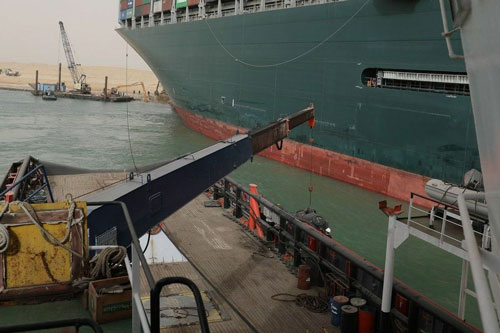The Suez Canal jam, caused by a stranded container ship, has posed an unprecedented challenge to the global supply chain, pushing businesses to look for new options to diversify their trading routes, especially along the Belt and Road, which during the pandemic has become a major channel for cargo transportation and anti-virus supplies from factories in China to the markets in Europe.
While the backlog was finally cleared nearly two weeks after the blockage caused by the grounding of Japanese-owned cargo ship Ever Given, the aftermath of the congestion has still sent shivers down traders’ spines.
Several traders that the Global Times reached following the canal congestion said that they have received increasing inquiries from clients asking about changing transport methods from ship to train in order to get their goods delivered on time.
Some said that the new inquiries concerning train cargo services have jumped three-fold since the jam.
Buck the trend Suez Canal Authority has said that all 422 ships stranded by the grounding of the giant container ship Ever Given passed through the canal by Saturday, ending the backlog caused by the blockage, Aljazeera reported on Saturday.
However, experts believe that the aftermath of the jam could last much longer and deeper.
Allianz, the German insurance giant, estimates that the blockage of the Suez Canal could cost global trade between $6 billion and $10 billion a week.
At the same time, the container shortage that was exacerbated in the second half of last year would be worsened, industry experts said.
‘This was a relatively short blockage, but its consequences will be felt for a long time and will serve as a boost to China and Russia, both of whom are introducing new game-changing intercontinental freight routes,’ Tom Fowdy, a British political and international relations analyst, said in his RT article published on March 30.
Fowdy’s words echoed the rising popularity of the China-Europe freight train. According to Zhou Shihao, founder and CEO of YQNLINK, a global logistics online services platform, there are more people asking them about the train services these days following the canal jam.
While some goods of Zhou’s company were stranded on the ships in the canal, they have started offering more alternatives for clients with urgent needs, including cross-border freight trains.
‘We have seen client queries about China-Europe cargo trains jump 2-3 times since the canal was blocked,’ said Zhou.
Another trader in the international cargo business and working for a large cargo company in East China’s Zhejiang, named Bao, told the Global Times on Sunday that even after the jam was cleared, international shipping companies are still having huge backlogs of cargo to unravel, which takes additional time, adding that they just cannot afford any more delays after the canal jam.
In the last week, Bao’s company has shipped about 30-35 percent more goods via the trains dispatching urgent goods, including several containers of electronic devices from Yiwu to Hamburg, after some of their goods were already held up on ships at the canal.
Such a change in transport use is expected, given the advantages of trains compared to sea transport regarding price and time, industry insiders said.
‘What normally takes 30-40 days by ship from China to Europe, only takes 15-25 days by train,’ said Zhou, noting that during the blockage, some ships needed to detour around the Cape of Good Hope, taking an additional 10 days. Not only are trains faster than ships, but their on-time rate is also higher.
‘The punctuality of the cross-border train between China and Europe can be up to 80 percent in general terms, whilst sea transport is only around 40-60 percent due to the low operation rate at some overseas ports caused by the pandemic,’ Wu Minghua, an independent shipping industry analyst from Shanghai, told the Global Times.
To ensure the fast delivery of goods and smooth trade flows, Urumqi’s customs office in Xinjiang is completing customs clearance in one to two hours, a source with the office told the Global Times.
Such high efficiency is contributed in part by the high level of automation in loading and unloading goods and the digitization of customs clearance, enabling freight train transfer verification procedures for exported goods to be handled in 20 minutes, according to customs.
China’s Belt and Road Initiative has invested hundreds of billions in the creation of new ports, railways, and roads on multiple continents, all of which are changing the logistical landscape, according to Fowdy.
More than 2,000 freight trains were running from China to Europe in the first two months of 2021, double the number at the same time a year ago.
Other routes While the upward trend toward freight trains is resilient, there are also limitations compared with ships.
‘The ships’ capacity is at least five times bigger than trains, and although railways can be expanded, the gap is still big, making it essential to further diversify the trade routes,’ said Wu.
Other routes, such as detouring to the Cape of Good Hope, are a new alternative for many Chinese traders.
Although the detour would take an extra week than the canal, a freight agent in Ningbo said, it would not necessarily cost more financially because the extra fuel would almost equal the passage fees charged by the Suez Canal.
Other alternative lines that have come under discussion after the jam are via the Arctic. The total journey from Shanghai to London via the Suez Canal is around 10,413 sea miles, but the Arctic route in the north is only around 8,000, experts said.










